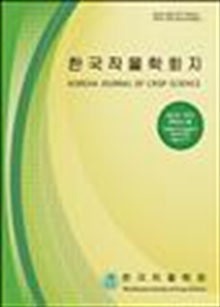간행물
한국작물학회지 KCI 등재 Korean Journal of Crop Science

- 발행기관 한국작물학회
- 자료유형 학술지
- 간기 계간
- ISSN 0252-9777 (Print)2287-8432 (Online)
- 수록기간 1963 ~ 2017
- 주제분류 농수해양 > 농학 농수해양 분류의 다른 간행물
- 십진분류KDC 524DDC 633
권호리스트/논문검색
제44권 3호 (1999년 9월) 23건
21.
1999.09
서비스 종료(열람 제한)
Nineteen japonica and Tongil-type rices were selected from seventy nine Korean and Japanese rice cultivars grown in 1989 based on the water uptake behavior of milled rice under the room temperature and boiling conditions. The selected rice cultivars were investigated for water absorbability and some physicochemical characteristics of milled rice, proper water amount for cooking and sensory evaluation of cooked rice. The relationships among the tested grain properties were also examined. The highest varietal variation of water uptake rate was observed at twenty minutes after soaking in water. The maximum water uptake of milled rices at room temperature occurred mostly at about eighty minutes after soaking in water. Newly harvested rices showed a significantly lower water uptake rate of milled rice at 20 minutes after soaking, a relatively higher maximum water absorption ratio under the room temperature, and the less water uptake and volume expansion of boiled rice compared with the one-year old rice samples. The water uptake rate and the maximum water absorption ratio showed significantly negative correlations with the K/Mg ratio and alkali digestion value(ADV) of milled rice. The rice materials showing the higher amount of hot water absorption exhibited the larger volume expansion of cooked rice. The harder rices with lower moisture content revealed the higher rate of water uptake at twenty minutes after soaking and the higher ratio of maximum water uptake under the room temperature condition. These water uptake characteristics were not associated with the protein and amylose contents of milled rice ansd the palatability of cooked rice. The water/rice ratio(in w/w basis) for optimum cooking was averaged to 1.52 in dry milled rices (12% wet basis) with varietal range from 1.45 to 1.61 and the expansion ratio of milled rice after proper boiling was averaged to 2.63(in v/v basis). The water amount needed for optimum cooking was the lowest in Cheongcheongbyeo (Tongil-type rice) and the highest in Jinbubyeo, and the amount could be estimated with about 70% fittness by the multiple regression formula based on some water uptake characteristics, ADV and amylose content of milled rice as the independent variables. Nineteen rice cultivars were classified into seven groups based on scatter diagram projected by principal component analysis using eight properties related to water uptake and gelatinization of milled rice.
22.
1999.09
서비스 종료(열람 제한)
The concerns on the crop damage by ultraviolet (UV) radiations is increasing owing to the decrease of their absorbing stratospheric ozone in the tropospheric. Cultivar differences on early growth of UV radiation among five Korean rice cultivars, four japonica types and one Tongil type (indica-japonica cross hybrid), were studied. Pot-seeded rice plants were grown under four different radiation conditions, i.e., visible radiation only, visible radiation with supplemented with high or low dose of UV-B (280~320 nm in wavelength) and UV-C (less than 280 nm in wavelength). The inhibitory degree on plant height, shoot and root weight and length of leaf blade and leaf sheath were determined at 40 days after seeding. UV-C showed the most severe inhibitory effect on the degree of biomass gain and leaf growth in most cultivars examined, followed by high UV-B and low UV-B. Among the cultivars used, the Kuemobyeo was the most sensitive cultivar and had not repair or showed resistance ability to continued irradiation of UV radiation. However, Janganbyeo and Jaekeon showed different responses that the elongation of leaf blades was promoted on 2nd and 3rd leaves and inhibited on 4th and 5th leaves but this inhibitory degree was reduced on 6 th and 7th leaves. Such tendency on leaf growth means that both cultivars had low sensitivity and most resistant ability to continued irradiation of UV radiation. While Tongil showed different response to enhanced UV radiation, ie., low UV-B promoted leaf growth but the inhibitory was severely increased by continued irradiation of high UV-B and UV-C, which means that Tongil had high threshold of UV radiation for response as an inhibitory light of plant growth. The results of this study indicate that the differences on sensitivity or resistant to the effects of UV radiation were existed among Korean rice cultivars
23.
1999.09
서비스 종료(열람 제한)
Hamlet (PI549276) possessing 2RL was obtained by cross between a wheat cultivar ND7532 (Froid/Centurk) and a rye cultivar Chaupon. Chaupon was known to have resistant gene to biotype L of Hessian fly [Mayetiola destructor (Say)] larvae. The wheat-rye translocation line (Coker797*4/Hamlet) was also known to be resistant to biotype L of Hessian fly larvae. We analysed a set of 96 ESTs from the wheat-rye translocation line (2BS/2RL). ESTs were classified by various physiological processings, such as primary metabolism, secondary metabolism, transcription, translation, transport, signal transduction, defense, transposable element, and others. Three sequences encoding thioredoxin peroxidase, 26S rRNA, and rubisco small subunits were homologous to registered genes in rye. Although limited number of clones were used to develop ESTs, these clones and their sequence information may be useful for researchers studying general physiology and molecular biology on the translocation line.
1
2

